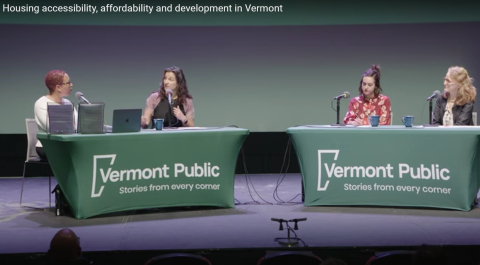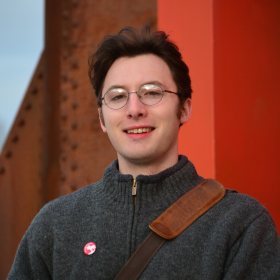A recording of the NPR show "1A" with Jenn White focused on the challenges of Vermont's housing landscape is now available through Vermont Public. White was joined at a live recording in Essex Junction on May 1, 2024 by VHFA's Executive Director Maura Collins, Carly Berlin, Housing/Infrastructure Reporter for Vermont Public and VTDigger, and Nancy Owens, President at Evernorth. Listen at https://www.youtube.com/watch?v=TNmfnWx8HPA.

Host Jenn White framed the discussion by pointing to recent data posted by VHFA researchers showing rising home prices and decreased home sales. She then asked the panelists to sum up Vermont’s current housing conditions in a single word and suggest solutions to Vermont’s housing crisis.
Maura Collins said she’d describe Vermont’s situation as "unsurprising," acknowledging that the core of the problem lies in the long-term trend of supply failing to meet demand due to decades of underbuilding in our state. Acknowledging some surprising factors, she explained that “this interest rate environment of such a fast, sharp increase has really turned up the pressure on folks' ability to afford housing, and yet I think the systemic issues that have been happening for a long time did contribute to this. I’m pleased to see we’re starting to address this in the legislature, and in our communities. I do think things are changing. Our public discourse and our awareness are so much broader now.”
To reverse the trend in underbuilding, Collins encouraged Vermont to continue examining the impact of zoning rules. “Minneapolis stands out to me as an example, NPR had a Weekend Edition on it recently. They made the kind of planning and zoning changes that Vermont has been modeling in a lot of our legislation.” By easing restrictions on home building, Minneapolis was “able to grow their housing stock by 14%, and the rents only went up by 1% since 2017… I’m hoping Vermont can follow suit.”
Reporter Carly Berlin described Vermont’s housing situation as "gridlocked", pointing to the extremely low rental vacancy rates and limited home buying options which has kept Vermonters stuck in place and contributed to rising rates of homelessness. Evernorth’s Nancy Owens described Vermont’s housing market as “feeling broken [because] it’s not working how we expect or how we have seen in the past.”
Vermont has unique strengths pertaining to the balance of housing and environmental conservation, such as the Vermont Housing and Conservation Board that is funded in part by revenues from the state’s property transfer tax. Collins explained that ”Vermont has a 35-year history of not falling into the trap of pitting housing against environment… as the market gets hotter, we are investing more in both housing and land conservation, funding both equally so that we are preserving and protecting where need to, while also driving the growth of downtowns.”
Owens described the benefits for affordable housing when municipalities take actions that trigger exemptions for some home building from Act 250 requirements. She continued to explain that providing affordable housing developers with decisions about permitting clearly and quickly is “the best solution because time is money in this situation.” She described a recent example with a proposed Evernorth project in Putney where 4 years of permitting delays due to appeals upped the project’s costs by $5 million.
Since the 1A panel discussion, Vermont’s legislature passed H.687 to streamline development rules, including some changes to Act 250, to accelerate housing development in downtown and village center areas.
When asked about the state’s strategy regarding the construction of affordable housing, Collins made clear that support for construction of homes at all price levels is key to addressing Vermont’s housing crisis:
“Affordable housing in many ways is a misnomer, because we start thinking that we’re building housing, we’re building apartments. And that’s true, we’re building apartments, but when we use public money, we’re also revitalizing our downtowns and we’re preserving historic structures. So if you imagine that iceberg and look below the waterline, you see we’re also addressing homelessness, providing services, cleaning up dirty soils, and reducing greenhouse gas emissions because of where we’re putting the housing and the smart transportation connections that we have. But I also think that the market-rate housing is critical. Housing has not been affordable at the very-low-income band for a very long time… For the last several years, the challenge of housing affordability has been reaching up the income band. People making upwards of six figures can’t find a place to rent, much less own. So we need all the housing, of all the types, of all the price points to address this issue.”
Panelists also emphasized that in order to build enough housing for everyone that wants to live in Vermont, a culture needs to grow, particularly in rural areas, in which local residents actively encourage the development of more housing in their towns. Collins described strategies for Vermont communities to do this:
“Just about every town in Vermont has a cemetery, which means they have a cemetery commission. There are by contrast, probably fewer than 20 local housing commissions. So we clearly care more about where we’re living in the afterlife, than where we’re living today… VHFA has been supporting the creation of local commissions, and provide resources with local data about housing needs, and showing them the policies that work. If I’m in a town that has a lot of retail, what are the taxes and fees that can help support the workers who support that retail… what are the changes that can address absentee landlords, or, if I’m in a ski community and see short-term rentals skyrocketing, what can I do to address that and make sure there’s more permanent housing for residents? The conversation has to start and end locally, because that’s where the rubber meets the road and where the housing has to be created.”
Evernorth president Nancy Owens summed up the key question facing Vermont communities going forward: “Can we accept having larger buildings, and more people? I don’t want to just accept it, I want to see more people here, and I want to see everybody housed.”

